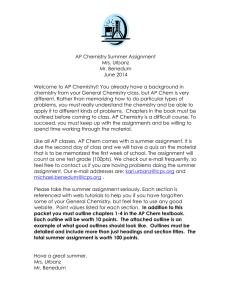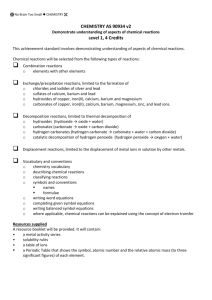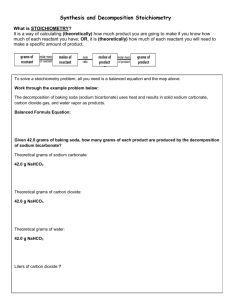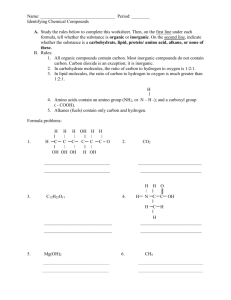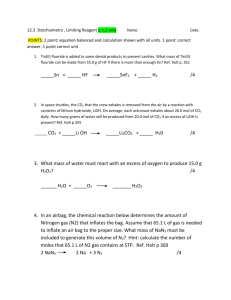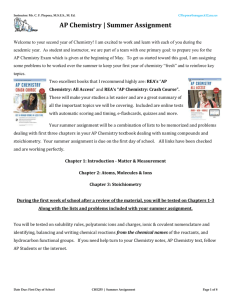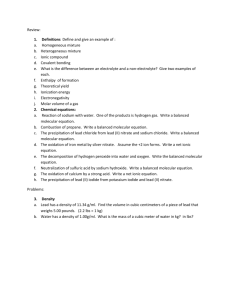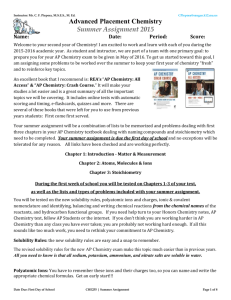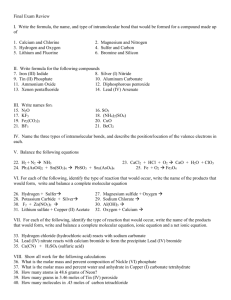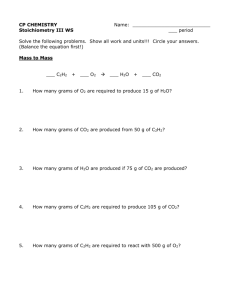AP Chemistry Summer Assignment
advertisement
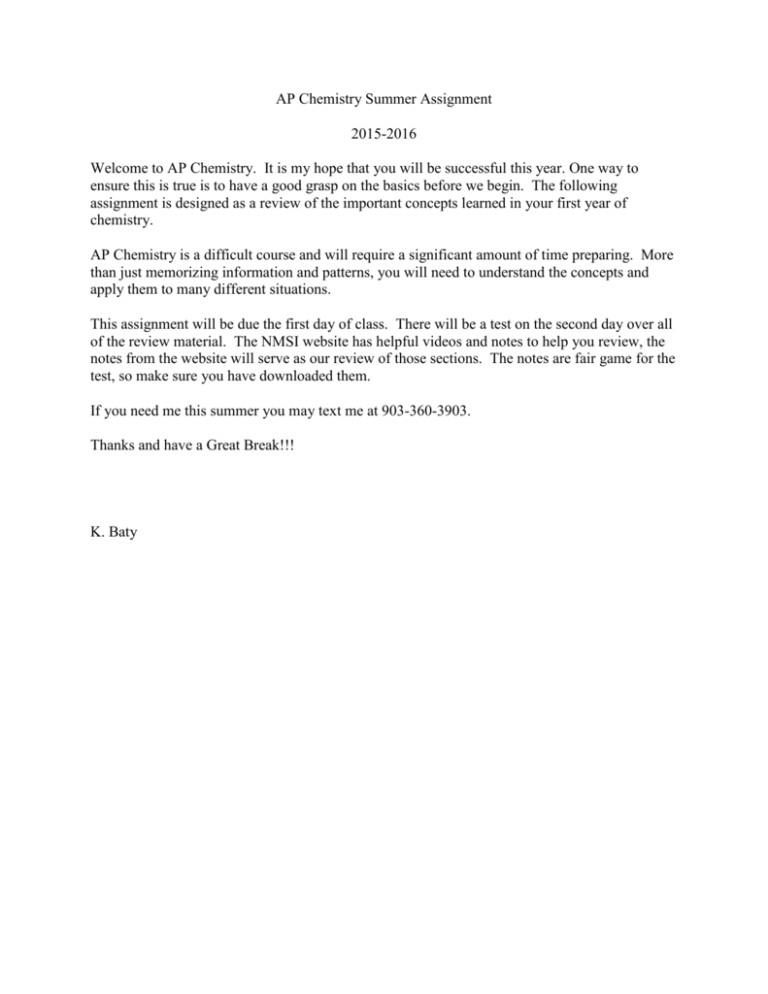
AP Chemistry Summer Assignment 2015-2016 Welcome to AP Chemistry. It is my hope that you will be successful this year. One way to ensure this is true is to have a good grasp on the basics before we begin. The following assignment is designed as a review of the important concepts learned in your first year of chemistry. AP Chemistry is a difficult course and will require a significant amount of time preparing. More than just memorizing information and patterns, you will need to understand the concepts and apply them to many different situations. This assignment will be due the first day of class. There will be a test on the second day over all of the review material. The NMSI website has helpful videos and notes to help you review, the notes from the website will serve as our review of those sections. The notes are fair game for the test, so make sure you have downloaded them. If you need me this summer you may text me at 903-360-3903. Thanks and have a Great Break!!! K. Baty Memorize the following polyatomic ions. Polyatomic Ions ammonium acetate Bromate Perchlorate Chlorate Chlorite Hypochlorite Cyanide Hydrogen phosphate Dihydrogen phosphate Hydrogen carbonate (bicarbonate) Hydrogen sulfate (bisulfate) Hydrogen sulfite (bisulfite) Hydroxide Iodate Nitrate Nitrite Permanganate Thiocyanate Carbonate Dichromate Chromate Oxalate Selenate Silicate Sulfate Sulfite Phosphate Phosphite Name Symbol NH4C2H3O2Bro3ClO4ClO3ClO2ClO CNHPO3H2PO3HCO3HSO4HSO3OHIO3NO3NO2MnO4SCNCO32Cr2O72CrO42C2O42SeO42SiO42SO42SO32PO43PO33- I. Chemical Formulas: http://tinyurl.com/clos37y Chapter: 02 – Atoms, Molecules, & Ions - This will serve as our review for this section of PreAP chemistry so make sure you download the notes and watch the videos. Write the formulas for the following: Name each of the following: a. Barium sulfate ________________ a. CuSO4 _____________________ b. Ammonium chloride _____________ b. PCl3 _______________________ c. Chlorine monoxide _____________ c. Li3N _______________________ d. Silicon tetrachloride ____________ d. BaSO3 _____________________ e. Magnesium fluoride ____________ e. N2F4 _______________________ f. Sodium oxide ________________ f. KClO4 _______________________ g. Sodium peroxide _____________ g. NaH ________________________ h. Copper (i) oxide _____________ h. (NH4)2Cr2O7 ___________________ i. Zinc sulfide _________________ i. HNO2 * _______________________ j. Potassium carbonate ___________ j. Sr3P2 ________________________ k. Hydrobromic acid ____________ k. Mg(OH)2 _____________________ l. Perchloric Acid ______________ l. Al2S3 ________________________ m. Lead (ii) acetate _____________ m. AgBr ________________________ n. Sodium permanganate ____________ n. P4O10 _______________________ o. Lithium oxalate _______________ o. HC2H3O2 * ___________________ p. Potassium cyanide ______________ p. CaI2 _________________________ q. Iron (iii) hydroxide ______________ q. MnO2 ________________________ r. Silicon dioxide _________________ r.Li2O _________________________ s. Nitrogen trifluoride _____________ s. FeI3 _________________________ t. Chromium (iii) oxide _____________ t. Cu3PO4 ______________________ u. Calcium chlorate ________________ u. PCl5 _________________________ v. Sodium thiocyanate ______________ v. NaCN _______________________ w. Nitrous acid ____________________ w. HF * _________________________ * - Name as acids II. Stoichiometry: Show all of your work for the following problems: http://tinyurl.com/clos37y Chapter 03 – Stoichiometry - Download notes & watch videos. This will serve as our review for this section. Stoichiometry is a major part of what we will do this year. 1. Find the mass percent of nitrogen in each of the following compounds: a. NO b. NO2 c. N2O4 d. N2O 2. Benzene contains only carbon and hydrogen and has a molar mass of 78.1 g/mol. Analysis shows the compound to be 7.44% hydrogen by mass. Find the empirical and molecular formula of benzene. 3. Calcium carbonate decomposes upon heating, producing calcium oxide and carbon dioxide. a. Write a balanced chemical equation for this reaction. b. How many grams of calcium oxide will be produced after 12.25 grams of calcium carbonate are completely decomposed? c. What volume of carbon dioxide gas is produced from 12.25 grams of calcium carbonate at STP? d. What is the volume of carbon dioxide in L if the pressure is 785 mmHg and the temperature is 30.0°C? (R=62.4mmHg-L/K-mol) 4. Hydrogen gas and bromine gas react to form hydrogen bromide gas. a. Write a balanced equation for this reaction. b. 3.2 grams of hydrogen reacts with 9.5 grams of bromine. Which is the limiting reactant? c. How many grams of hydrogen bromide gas can be produced using the amounts in (b)? d. How many grams of excess reactant are left unreacted? e. What volume of HBr, measured at STP is produced in (b)? 5. When ammonia gas, oxygen gas and methane gas (CH4) are combined, the products are hydrogen cyanide gas and water. a. Write a balanced equation for this reaction. b. Calculate the mass of each product produced when 225 grams of oxygen gas react with an excess of the other two reactants. c. If the actual yield of the experiment in (b) is 105 grams of HCN, calculate the percent yield.

